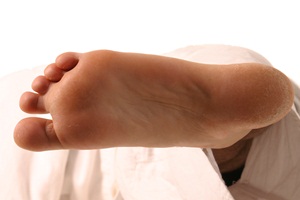What You Can Do to Stop Plantar Fasciitis Pain
 It’s the pain in your feet when you get out of bed and walk a few steps in the morning…it’s uncomfortable, a bad way to start the day and it may be Plantar fasciitis (pronounced “plan-tar fash-ee-EYE-tis), also sometimes known as a heel spur.
It’s the pain in your feet when you get out of bed and walk a few steps in the morning…it’s uncomfortable, a bad way to start the day and it may be Plantar fasciitis (pronounced “plan-tar fash-ee-EYE-tis), also sometimes known as a heel spur.
This can be a debilitating condition that makes walking even a short distance a painful prospect. The pain, ranging from mild to severe, is typically centered around the bottom of the heel though it may also extend across the entire bottom of the foot. It is often most noticeable first thing in the morning when you get out of bed and take those few steps or when you stand up after sitting for a long time.
What causes plantar fasciitis?
There are a number of possible causes for this condition that we inherit or accumulate over time. The main ones are:
-Standing for long periods of time
-Wearing shoes with little support
-Having flat feet
-Having exceptionally high arches
-Being overweight
-A sudden increase in activity
-Repetitive stress
-Tight calf muscles
-Overpronation (walking on the outsides of your feet)
-Aging
The plantar fascia is a band of tough fibrous tissue that extends from the heel bone to the base of the toes. When it becomes irritated and stretched due to one of the above conditions, pain and bone spurs can result.
The muscles in your foot may also be involved, especially if the pain occurs after long periods of standing, lots of walking usually because the foot is working to constantly try to correct it’s position in poorly fit shoes. With overwork, the from these activities, muscles in your feet tend to shorten, becoming less resilient and more liable to tear.
Healing usually takes time. However, there are some things you can do to help ease the pain and speed the healing process.
What you can do to ease the pain of plantar fasciitis:
Get expert treatment- this starts at your chiropractor’s office, getting evaluated to see if specific body adjustments and therapy to your feet may help. The treatment prescribed can decrease the tightness and pain and may involve the use of pain-less manipulation of the foot, stretching, ultrasound and soft tissue work.
Since one common cause of plantar fasciitis is overpronation, a series of chiropractic adjustments can ensure your bones are properly aligned, allowing for greater range of motion and helping to take some of the strain off the overworked muscles in your feet.
You might benefit from the use of uniquely prescribed orthotics from your chiropractor and exercises you can do at home to gently stretch tight muscles and tendons.
What can you do at home?
The first thing is to rest the foot as much as possible. Applying ice to the area can help reduce the inflammation, as can taking an anti-inflammatory such as ibuprofen. Many people with plantar fasciitis find it helpful to wear Birkenstocks or other shoes that have good arch support. In the long-term, however, you’ll want to address the cause of the problem and not rely heavily on over-the-counter medications or constantly “bandaging” the problem. As a chiropractor, I’ve seen people overcome this pain permanently.
Healing plantar fasciitis is a slow process that needs to be addressed as soon as it is a problem, if not sooner. The patterns have been in your feet for a long time, Much like you see a house settling, shifting and causing damage, your foot can shift and cause pulling and pain on the bones and joints. It may have taken weeks or months to get this way, but it is possible to stop the damage and the pain so it does not become a chronic problem in your life. Check out our free report “10 Questions to See if You Are Heading Towards a Foot, Ankle or Knee Injury and How to Prevent it”.